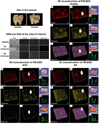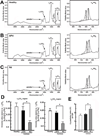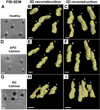Structural analysis of reactionary dentin formed in response to polymicrobial invasion
- PMID: 23261402
- PMCID: PMC3578079
- DOI: 10.1016/j.jsb.2012.12.005
Structural analysis of reactionary dentin formed in response to polymicrobial invasion
Abstract
In response to microbial invasion of dentin odontoblasts secrete an altered calcified matrix termed reactionary dentin (Rd). 3D reconstruction of focused-ion-beam scanning electron microscopy (FIB-SEM) image slices revealed helical tubular structures in Rd that contrasted with regular cylindrical tubules characteristic of dentin from healthy teeth and affected so-called physiological dentin (Pd) lying exterior to Rd. This helical structure in Rd provided effective constriction of tubule lumen diameter that formed a barrier to bacterial advance towards the dental pulp. SEM of resin cast preparations revealed altered extension of odontoblast processes through Rd. The distribution of key mineral elements was studied by combination of 3D reconstruction of focused-ion-beam based X-ray microanalysis (FIB-EDS), laser ablation-inductively coupled plasma-mass spectrometry (LA-ICP-MS) and diffuse reflectance infrared Fourier transform spectroscopy (DRIFTS). There was a marked redistribution of calcium and phosphorous in Rd together with an increase of diffusely deposited magnesium compatible with the mineral deposition phase of synthesis of this altered matrix. Changes in tubule structure and mineral content characteristic of Rd are consistent with reduced hardness and lower elastic modulus reported for this matrix. Findings provide insight into the unique structure of Rd synthesised as a primary response to infection.
Copyright © 2012 Elsevier Inc. All rights reserved.
Conflict of interest statement
Figures











References
-
- Addadi L, Geva M, Weiner S. On how proteins interact with crystals and their effect on crystal formation. Z Kardiol. 2001;90:92–98. - PubMed
-
- Addadi L, Raz S, Weiner S. Taking advantage of disorder: amorphous calcium carbonate and its roles in biomineralization. Adv Mat. 2003;15:959–970.
-
- Bergman B, Friberg U, Lohmander S, Oberg T. Morphologic and autoradiographic observations on the effect of zinc deficiency on endochondral growth sites in the white rat. Odontol Revy. 1970;21:379–399. - PubMed
-
- Blumenthal NC, Posner AS. Effect of preparation conditions on the properties and transformation of amorphous calcium phosphate. Mat Res Bull. 1972;7:1181–1190.
Publication types
MeSH terms
Grants and funding
LinkOut - more resources
Full Text Sources
Other Literature Sources
Miscellaneous

